
Overview
The essential elements for a conversion optimized website are pivotal in driving success. These elements include:
- User session recordings
- Competitor analysis
- Effective copywriting
- UI/UX design
- Customer surveys
- Ongoing A/B testing
- Analytics
- Clear calls to action
- Personalization
Collectively, these components enhance user experience and engagement, leading to improved conversion rates and overall business profitability. Numerous case studies and statistics substantiate their effectiveness in driving sales and customer satisfaction. By integrating these strategies, businesses can significantly elevate their online performance and achieve sustainable growth.
Introduction
In the fiercely competitive realm of online business, a website's success is fundamentally tied to its capacity to convert visitors into loyal customers. With consumer expectations reaching unprecedented heights, it is imperative for brands to grasp the essential elements that contribute to a conversion-optimized website.
This article explores ten pivotal strategies designed not only to enhance conversion rates but also to tackle the pressing challenges of customer engagement and retention.
How can brands adeptly integrate these elements to revolutionize their online presence and drive profitability?
Parah Group: Comprehensive CRO Services for Website Optimization
Parah Group commands a comprehensive suite of Conversion Rate Optimization services specifically designed for direct-to-consumer brands. Their offerings include:
- Session recordings
- Competitor analysis
- Strategic copywriting for enhancements
- UI/UX design
- Customer surveys
- Ongoing A/B testing
Each service is meticulously crafted to elevate success metrics and average order values, ensuring that every aspect of a client's website is optimized for peak performance. This not only boosts profitability but also effectively tackles the challenges posed by high customer acquisition costs and intensifying market competition.
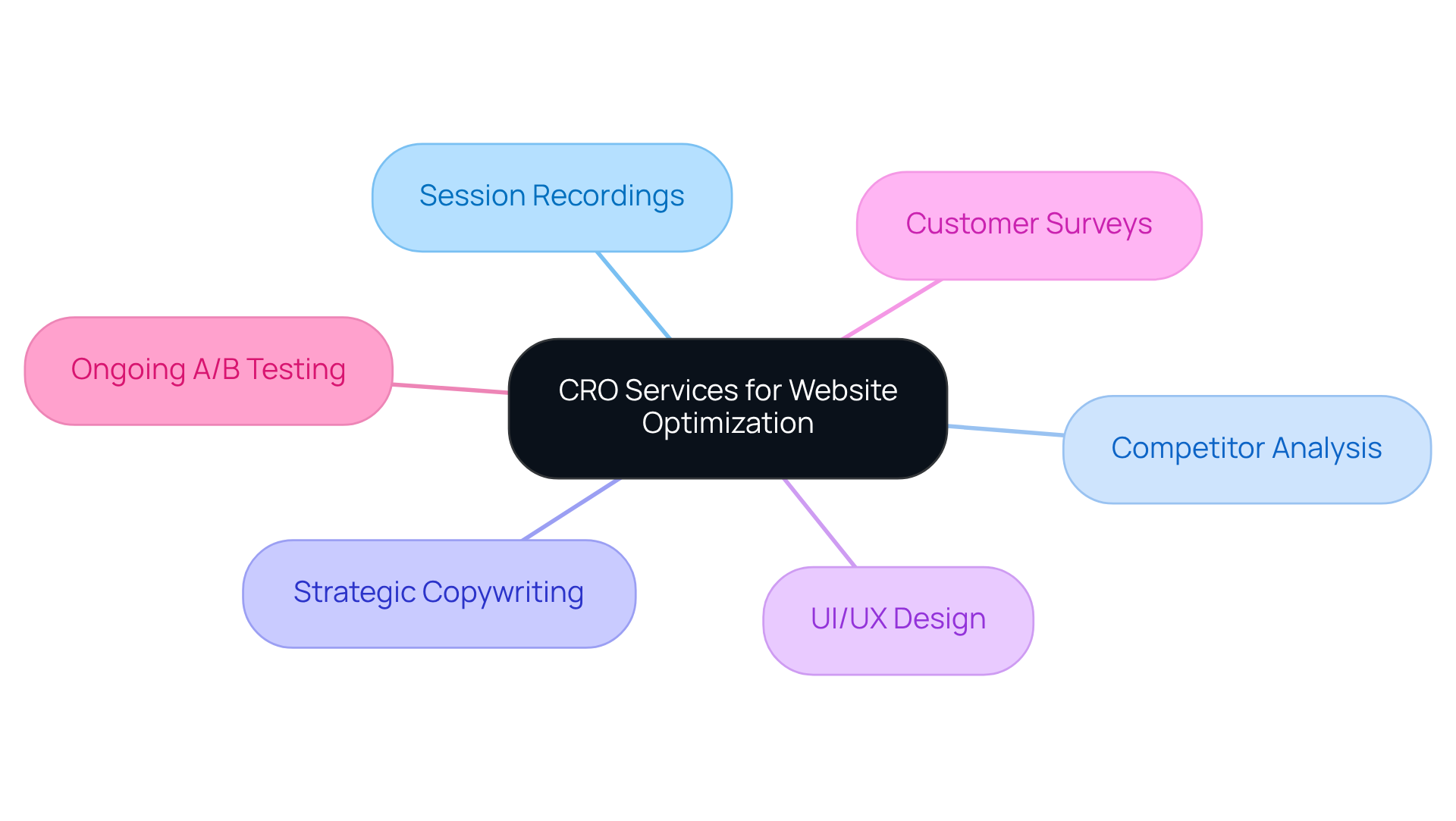
User Session Recordings: Analyze Visitor Behavior to Enhance Conversions
User are essential for comprehending visitor behavior on a website. By meticulously analyzing how individuals navigate through pages on their conversion optimized website, where they click, and where they abandon their activity, brands can pinpoint specific issues that hinder transactions. This data-driven approach facilitates targeted enhancements, such as optimizing navigation or refining content placement, ultimately leading to improved user experiences on a conversion optimized website and heightened engagement rates.
For instance, A/B tests conducted with Monetate showcased a remarkable 26% increase in engagement for users interacting with optimized elements. As VWO asserts, "Session recording helps you gauge the performance of different campaigns that you run," underscoring the pivotal role of understanding customer interactions.
Furthermore, it is crucial to evaluate metrics such as traffic sources and conversion barriers during this analysis. Ensuring data security in user behavior tracking is paramount, as it safeguards user privacy while yielding valuable insights. By scrutinizing visitor behavior, companies can make informed decisions that foster a more intuitive and engaging online environment, ultimately leading to a conversion optimized website and enhancing profitability.
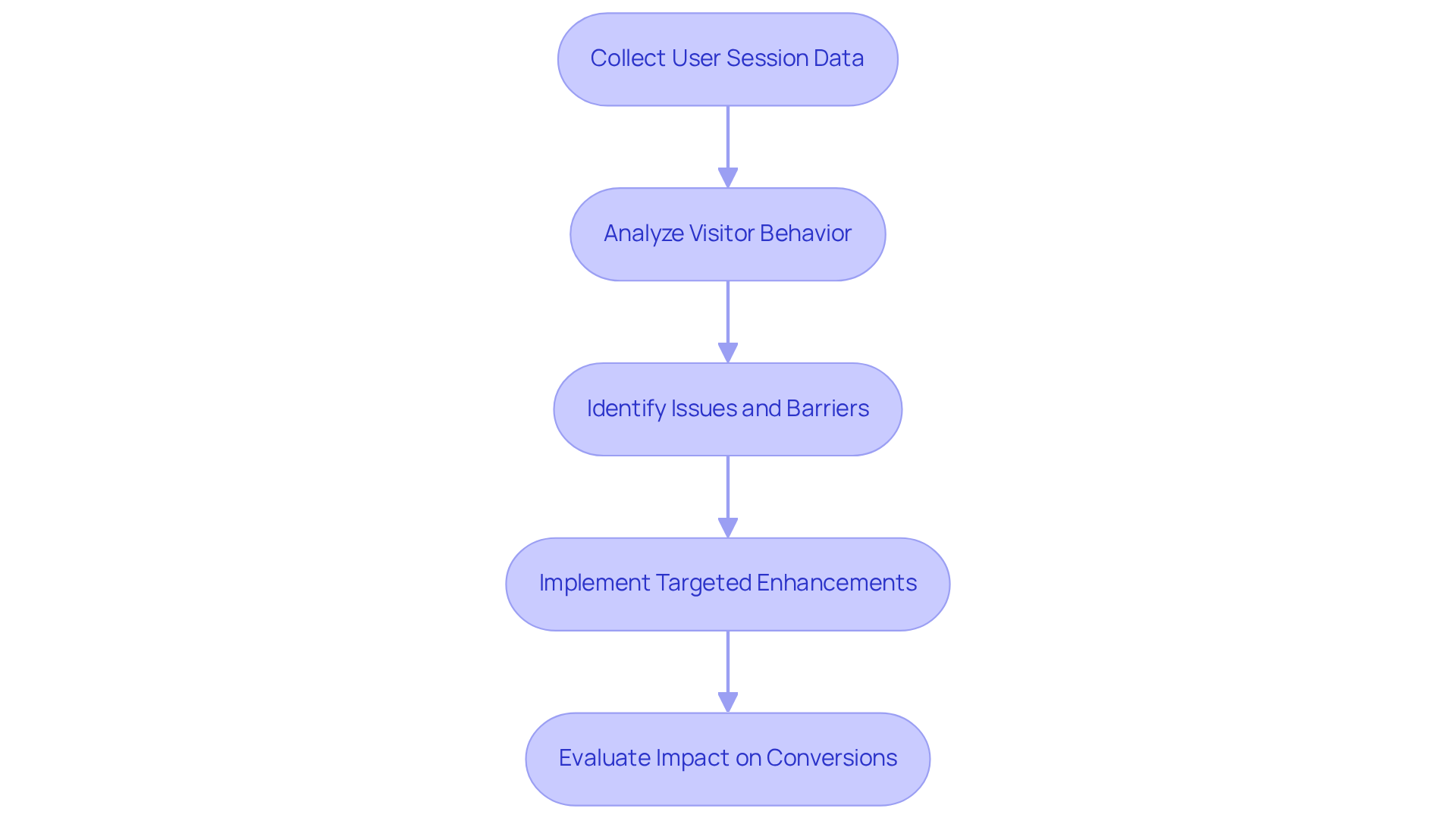
Competitor Analysis: Benchmark Against Industry Leaders for Better Performance
Conducting a comprehensive competitor analysis is essential for DTC companies aiming to benchmark their performance against industry leaders. This process involves a detailed examination of competitors' websites, marketing strategies, and customer engagement tactics. By recognizing both strengths and weaknesses, companies can incorporate successful elements and innovate on their own offerings, ensuring they remain competitive in a crowded marketplace.
In 2025, the average performance benchmarks for DTC companies indicate that those with a Net Promoter Score (NPS) above 62 tend to experience higher customer retention and revenue growth. Brands that effectively employ competitor analysis not only boost their sales performance but also increase their average order values (AOV). For instance, a $30M apparel company that partnered with Parah Group saw a 35% increase in conversion rates and a 10% rise in revenue per visitor after implementing strategies such as optimizing product pricing and gamifying the shopping experience. Similarly, Grab Green, a $15M cleaning product company, achieved an 80% increase in AOV by testing free shipping thresholds and introducing bundles to incentivize larger purchases.
Industry leaders emphasize the importance of this practice. As Edward de Bono states, "Companies that focus solely on competition will die. Those that focus on value creation will thrive." This viewpoint emphasizes the necessity for companies to not only observe rivals but also to obtained from their strategies.
Successful cases are plentiful; companies that have measured themselves against rivals have reported significant enhancements in their success metrics. For instance, STRNG Seeds, a rapidly expanding DTC cannabis company, enhanced their conversion rate by 55% by implementing targeted strategies and developing a conversion optimized website that included free gifts and optimized landing pages. By leveraging insights from competitor analysis, these companies have been able to refine their marketing strategies and enhance customer experiences through a conversion optimized website, ultimately driving growth and profitability. Furthermore, businesses that improve NPS by just 7 points can see revenue growth of up to 1% annually, highlighting the financial benefits of effective competitor analysis. In a landscape where competition is fierce, the ability to adapt and evolve based on industry benchmarks is crucial for sustained success. Regularly assessing competitors' NPS and marketing strategies can help identify areas for improvement and drive ongoing growth.
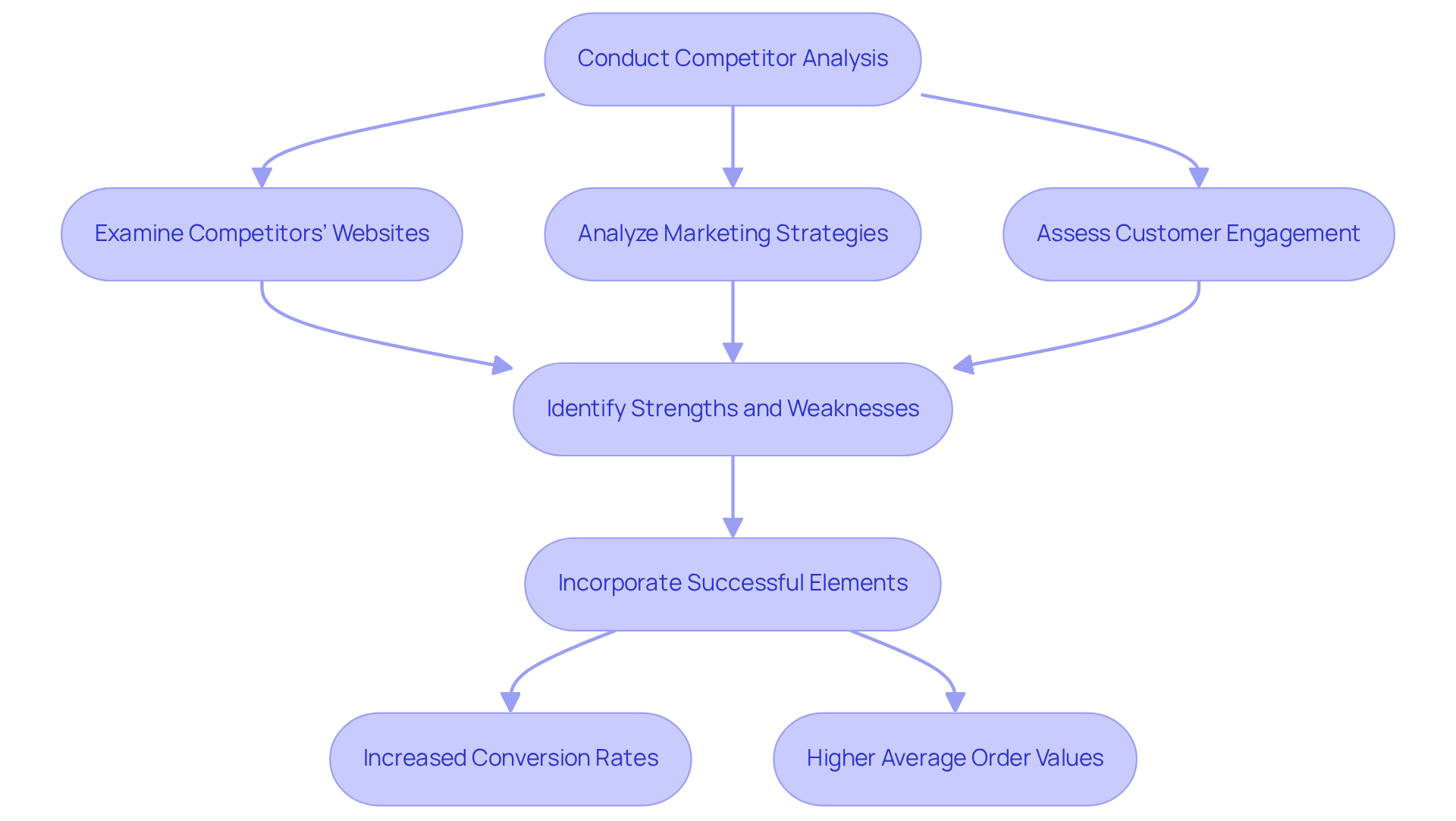
Conversion Copywriting: Craft Compelling Messages to Drive User Action
Conversion copywriting is vital for crafting messages that resonate profoundly with the target audience. It begins with a thorough understanding of customer pain points and desires, allowing companies to articulate solutions that inspire action. Effective copy transcends mere information; it persuades by harnessing psychological triggers that compel users to undertake desired actions, such as making a purchase or subscribing to a newsletter.
For example, brands that weave storytelling into their messaging can significantly elevate engagement by humanizing their offerings. Moreover, employing straightforward language can yield a 36% increase in response rates, as simpler communication tends to resonate more effectively with audiences.
Statistics reveal that personalized calls to action can boost results by over 200%, underscoring the power of customized messaging. Additionally, utilizing urgency and loss aversion tactics—framing inaction as a potential loss—can decisively influence user decisions. The combination of urgency and loss aversion can markedly enhance response levels, making it an indispensable element of any effective .
In summary, effective copywriting can result in an average increase in conversion rates of up to 30%, solidifying its role as a critical component of any successful conversion optimized website strategy.
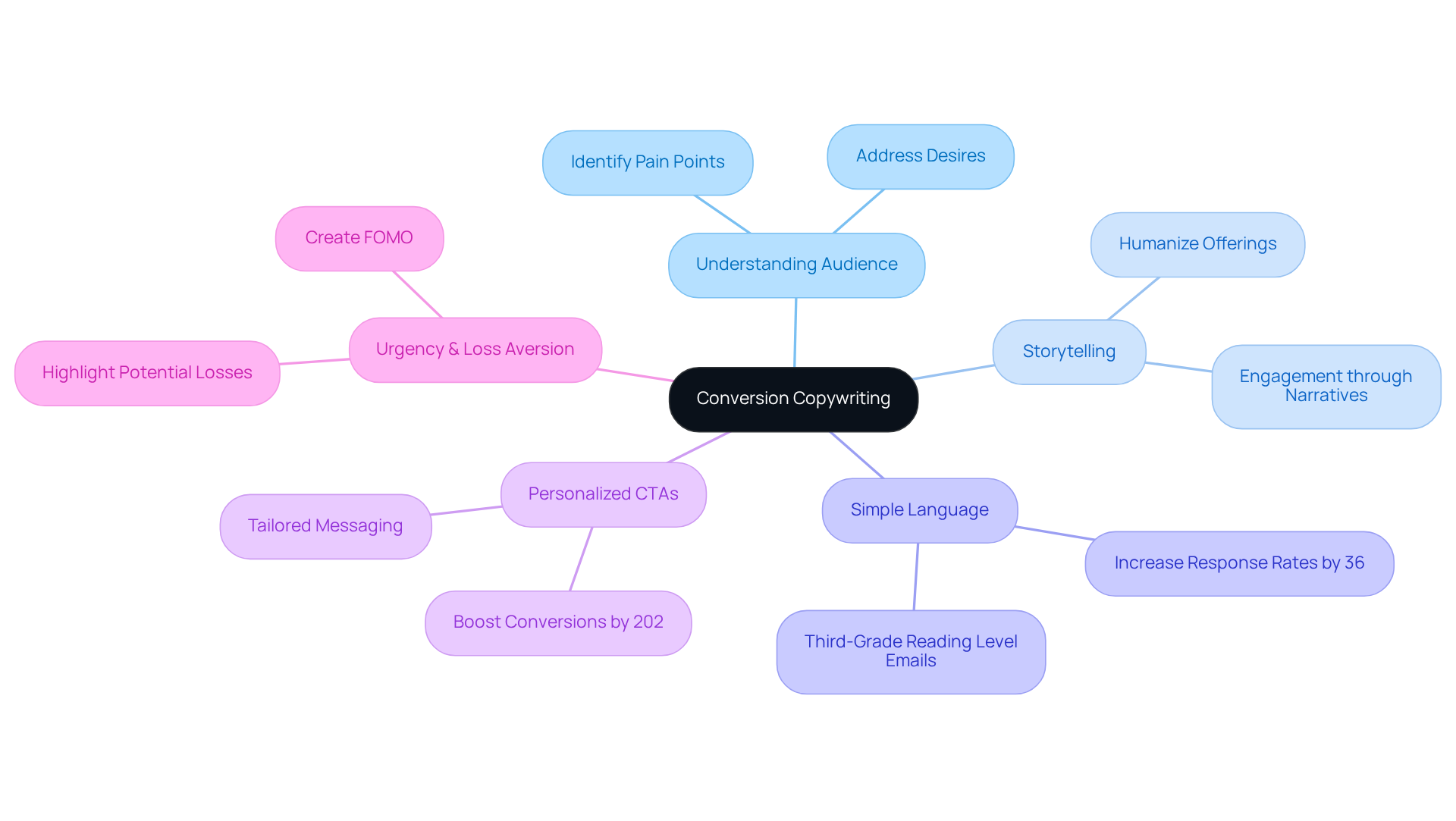
UI/UX Design: Create Intuitive Interfaces to Improve User Experience
is paramount for crafting intuitive interfaces that facilitate seamless experiences for users. A well-conceived conversion optimized website adeptly guides visitors through their journey, significantly reducing confusion and frustration. Key elements of successful design include:
- Clear Navigation: Users should effortlessly locate what they need without unnecessary clicks.
- Responsive Design: Websites must function effectively across various devices, ensuring accessibility for all.
- Visually Appealing Layouts: Aesthetic components should captivate visitors while maintaining functionality.
Focusing on customer experience enables companies to create a conversion optimized website that leads to substantial improvements in conversion rates and cultivates lasting customer loyalty. As Steve Jobs aptly stated, "Design is not just what it looks like and feels like. Design is how it works." This philosophy underscores the critical need to integrate user-centric design principles to enhance overall performance. Additionally, Lorinda Mamo observes, "Every great design begins with an even better story," emphasizing the importance of storytelling in design. Furthermore, research reveals that design-driven companies outperform their competitors by 228% and report 50% more loyal customers, underscoring the financial advantages of investing in quality design. Inclusive design is also vital, ensuring that all individuals, including those with disabilities, can navigate and benefit from the website effectively.

Customer Surveys: Gather Insights to Tailor User Experience
Customer surveys serve as a vital instrument for DTC companies seeking to extract insights directly from their users. By posing targeted questions regarding experiences, preferences, and pain points, brands can gather invaluable feedback that informs website optimizations. Notably, the average response rates for customer surveys in the DTC sector typically range from 15% to 30%, with SMS surveys achieving even higher response rates of 40% to 50%. Furthermore, the average response rate for email surveys hovers around 24.8%. This data significantly influences decisions across various factors, from product offerings to creating a conversion optimized website, ensuring that the user experience aligns with customer expectations and effectively drives conversions.
Market researchers underscore the critical nature of collecting user feedback, noting that even a modest 5% increase in customer retention can boost profits by as much as 75%. Prominent brands like Costco and Apple have adeptly tailored their experiences based on survey feedback, resulting in substantial enhancements in customer satisfaction and loyalty. By actively engaging with their clients, these companies not only refine their offerings but also foster a deeper connection with their audience, ultimately driving improvements in engagement.
Integrating client insights into the optimization process is paramount for boosting conversion rates on a conversion optimized website. Parah Group, an authority in Conversion Rate Optimization (CRO), emphasizes the importance of feedback-driven changes for a conversion optimized website. Brands that adopt such strategies frequently witness a notable increase in engagement and sales. By treating customer feedback as a strategic asset, DTC companies can develop a conversion optimized website that converts insights into actionable strategies, thereby elevating their overall performance. To , brands should concentrate on specific areas such as website navigation, product presentation, and overall user experience, ensuring that the insights gathered lead to meaningful enhancements that drive sustainable growth and increased profitability.

Ongoing A/B Testing: Experiment and Optimize for Maximum Conversions
Ongoing A/B testing is essential for creating a conversion optimized website. By systematically comparing two versions of a webpage—such as different headlines, images, or layouts—brands can pinpoint which elements drive greater engagement. This method not only facilitates immediate improvements but also cultivates a culture of continuous refinement, which is essential for a conversion optimized website.
For instance, firms like Wayfair have demonstrated that even minor adjustments, such as incorporating lifestyle images in advertisements, can yield substantial results, with a reported 21% increase in sales. Additionally, A/B testing can elevate average success rates by 2-3%, leading to significant profits over time.
As highlighted by CRO specialists like Božidar Savičić, "A/B testing transforms guesswork into data-driven decisions." To effectively implement A/B testing for a conversion optimized website, companies should:
- Establish clear objectives
- Select high-traffic pages
- Ensure an adequate sample size—targeting at least a few hundred visitors per variation
This organized approach not only boosts transactions but also aligns websites with evolving audience preferences.
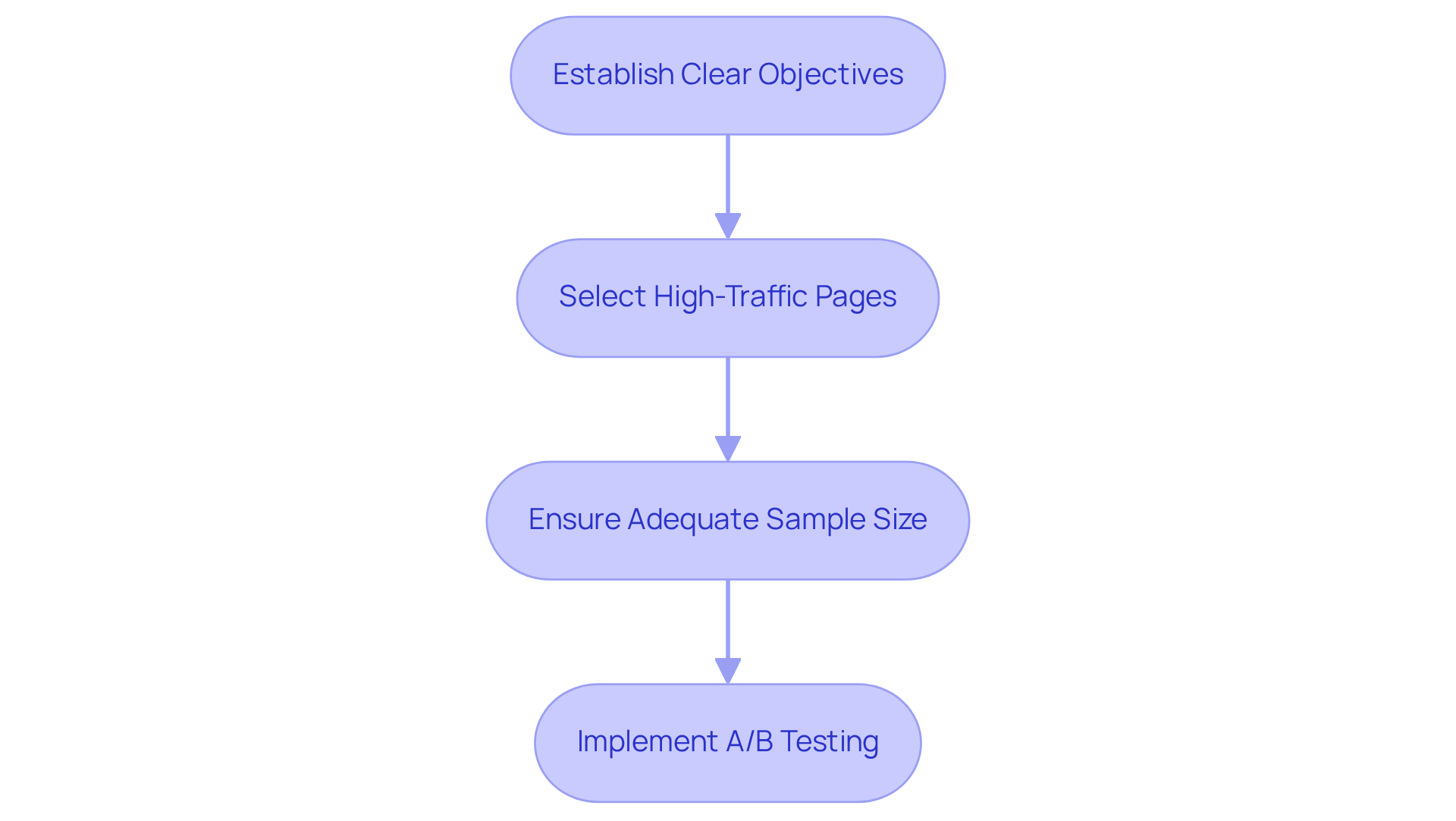
Analytics and Feedback: Monitor Performance to Drive Continuous Improvement
Analytics and feedback mechanisms are indispensable for effectively monitoring website performance. By scrutinizing essential metrics such as sales ratios, bounce rates, and audience engagement, brands can gain critical insights into the efficacy of their strategies. This data not only informs continuous improvement initiatives but also facilitates timely modifications that and drive superior results.
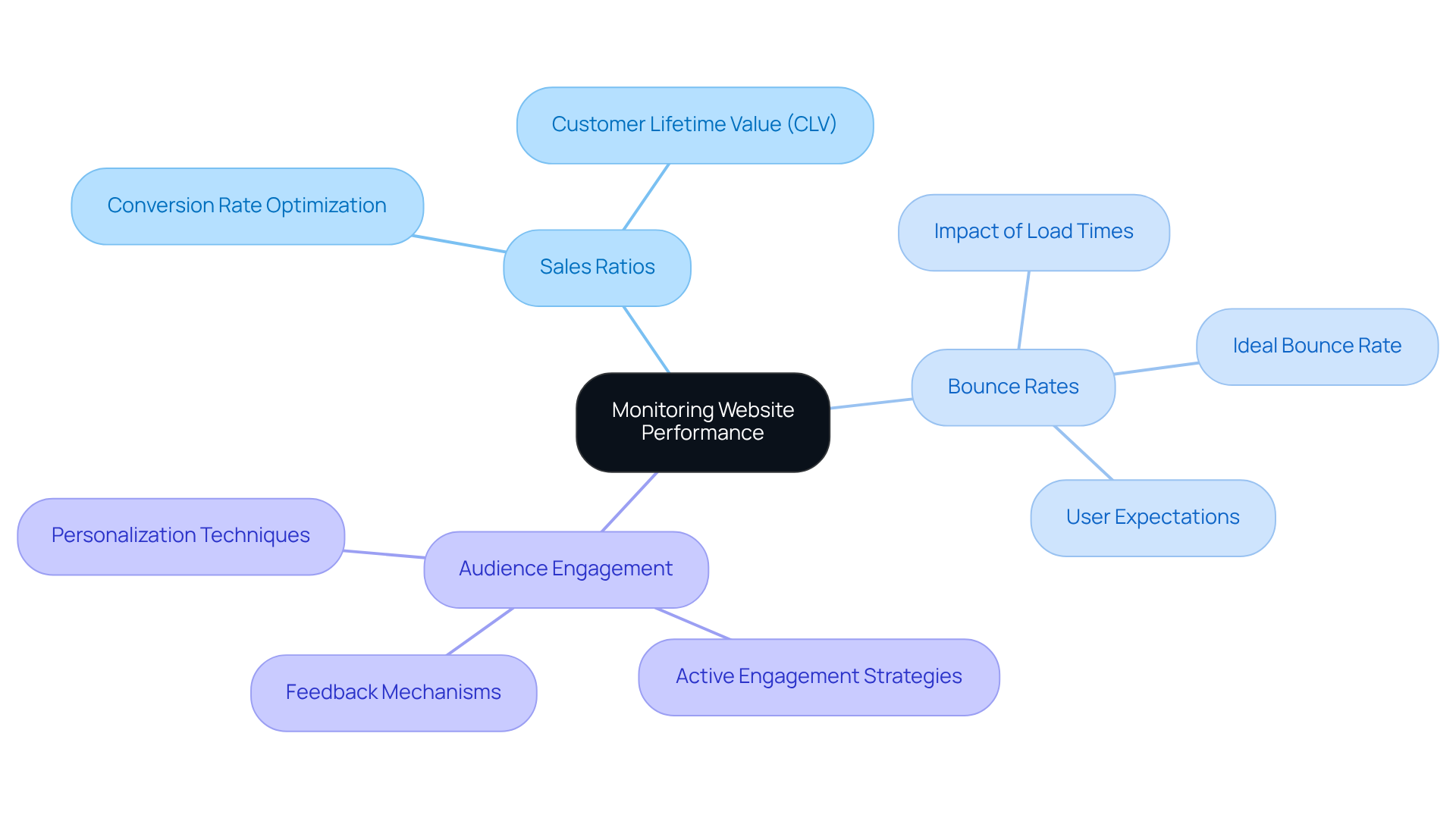
Clear Calls to Action: Direct Users Towards Desired Actions
Clear calls to action (CTAs) are paramount for steering visitors toward desired actions on a website. Effective CTAs must be prominently displayed, employ action-oriented language, and evoke a sense of urgency. For instance, brands that incorporate urgency signals in their CTAs can witness a staggering increase in success by up to 332%.
By explicitly guiding users on subsequent steps—be it making a purchase, subscribing to a newsletter, or downloading a resource—brands can markedly enhance their success in achieving objectives. Research indicates that the typical website conversion rate hovers around 2.4%; however, with well-optimized CTAs, this figure can surge to 11.5% or higher.
Noteworthy examples include Bani Kaur, whose CTAs leverage social proof, effectively communicating the value of her services and resulting in heightened engagement and favorable outcomes. Marketing professionals assert that relevant and strategically placed CTAs can boost revenue by an average of 83%.
Therefore, crafting clear and is essential for maximizing click-through rates and prompting actions. Furthermore, implementing A/B testing can further refine CTAs, ensuring they resonate with the target audience.
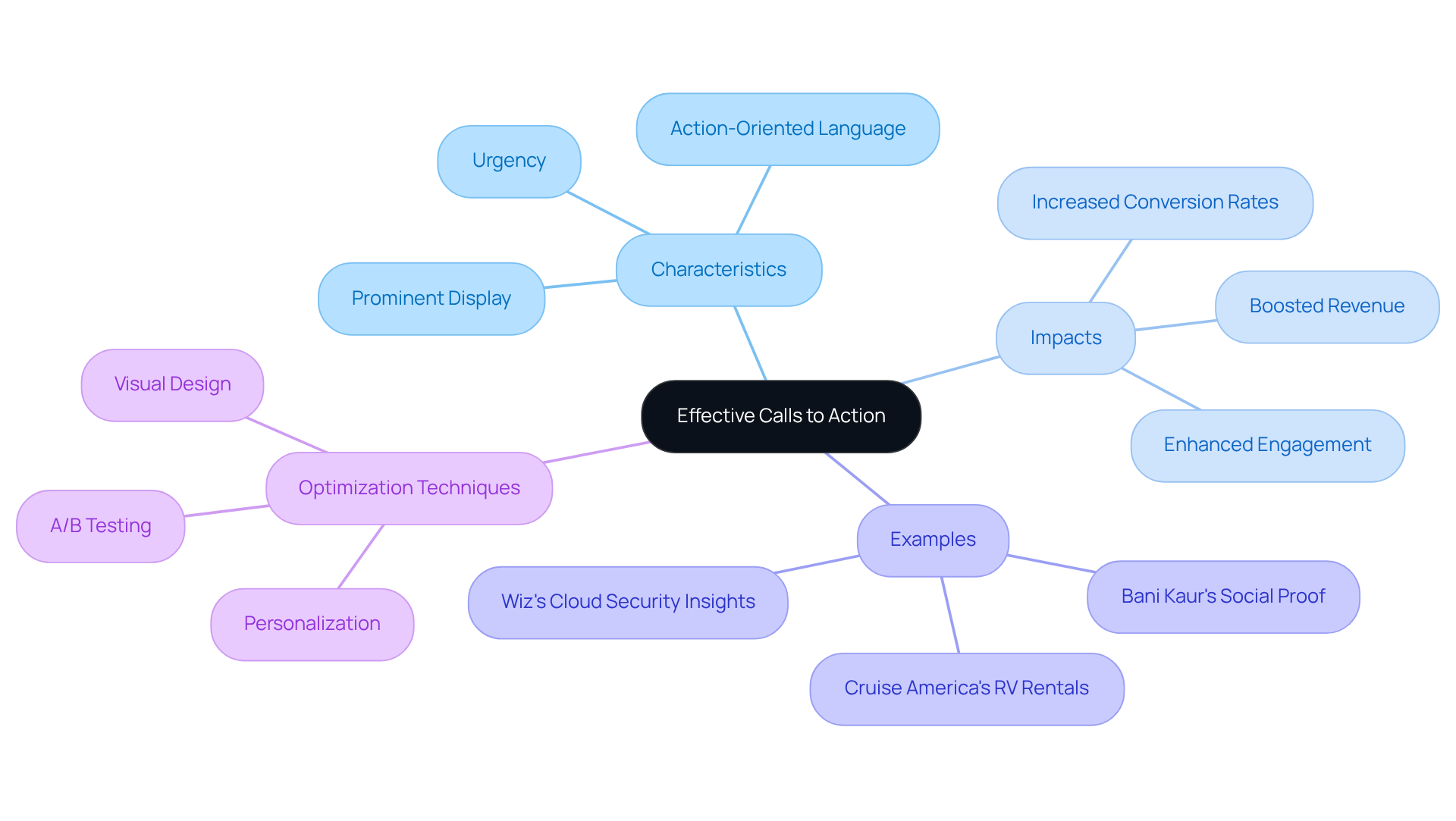
Personalization: Tailor User Experience to Boost Engagement and Conversions
Customization is paramount for crafting captivating experiences that significantly enhance outcomes. By scrutinizing user behavior and preferences, companies can tailor content, product suggestions, and marketing messages to resonate with individual users. This not only cultivates a deeper connection with the audience but also amplifies the likelihood of conversions and enhances overall customer satisfaction on a conversion optimized website.
Research reveals that:
- 91% of consumers are more inclined to purchase from companies that offer personalized suggestions.
- 85% are influenced to buy when the homepage features personalized promotions.
- Firms employing advanced personalization strategies report an impressive $20 return for every dollar spent, underscoring the tangible benefits of this approach.
- 74% of individuals express frustration when content fails to align with their needs, emphasizing the critical nature of effective personalization.
Successful brands like Amazon and Netflix exemplify how tailored experiences can drive increased conversion rates through a conversion optimized website by delivering relevant content that aligns with individual interests.
To adeptly customize content for specific individuals, businesses should:
- Leverage data-informed insights
- Categorize their audience based on behavior
- Consistently test and refine their strategies
Personalized landing pages can be developed based on user demographics and purchase history, exemplifying a conversion optimized website. Additionally, the case study "Using Personalization to Improve Customer Experience on Websites" illustrates the favorable outcomes of website personalization. This dedication to personalization not only fuels engagement but also fosters long-term customer loyalty.
Commence by analyzing your customer data to pinpoint key segments for targeted personalization.

Conclusion
A conversion optimized website is indispensable for direct-to-consumer brands aiming to elevate their online performance and profitability. By integrating essential components such as:
- User session recordings
- Competitor analysis
- Conversion copywriting
- Effective UI/UX design
companies can cultivate a seamless and engaging user experience that drives conversions. The necessity of continuous improvement through A/B testing, customer feedback, and analytics is paramount, as these practices empower businesses to refine their strategies and adapt to evolving consumer needs.
In this article, various strategies for achieving a conversion optimized website have been thoroughly examined. User session recordings yield valuable insights into visitor behavior, while competitor analysis enables brands to benchmark their performance against industry leaders. Conversion copywriting, complemented by clear calls to action, plays a pivotal role in motivating users to take desired actions, while personalized experiences significantly enhance engagement and satisfaction. Furthermore, ongoing A/B testing and feedback mechanisms ensure that websites remain effective and aligned with user expectations.
Ultimately, the significance of a conversion optimized website transcends mere metrics; it embodies a company's dedication to understanding and fulfilling the needs of its audience. By prioritizing these essential elements, brands can adeptly navigate the competitive landscape and achieve sustainable growth. Embracing these practices not only enriches the user experience but also positions companies for enduring success in an ever-evolving digital marketplace.
Frequently Asked Questions
What services does Parah Group offer for Conversion Rate Optimization (CRO)?
Parah Group offers a comprehensive suite of CRO services including session recordings, competitor analysis, strategic copywriting, UI/UX design, customer surveys, and ongoing A/B testing.
How do session recordings benefit brands?
Session recordings help brands understand visitor behavior by analyzing navigation patterns, clicks, and abandonment points. This data allows for targeted enhancements to improve user experiences and engagement rates on their websites.
What impact can A/B testing have on engagement?
A/B testing can lead to significant increases in engagement, as demonstrated by a 26% increase in engagement for users interacting with optimized elements in tests conducted with Monetate.
Why is competitor analysis important for direct-to-consumer (DTC) companies?
Competitor analysis is essential for DTC companies to benchmark their performance against industry leaders, identify strengths and weaknesses, and incorporate successful strategies to remain competitive in the marketplace.
What are some outcomes of effective competitor analysis?
Effective competitor analysis can lead to increased conversion rates and average order values. For example, a $30M apparel company saw a 35% increase in conversion rates and a 10% rise in revenue per visitor after implementing optimized strategies.
How can improving Net Promoter Score (NPS) affect revenue?
Companies that improve their NPS by just 7 points can see revenue growth of up to 1% annually, highlighting the financial benefits of effective competitor analysis and customer engagement strategies.
What role does data security play in user behavior tracking?
Data security is crucial in user behavior tracking as it safeguards user privacy while providing valuable insights into visitor interactions, which can inform decisions for enhancing online experiences.
Can you provide examples of companies that benefited from competitor analysis?
Yes, STRNG Seeds improved their conversion rate by 55% and Grab Green achieved an 80% increase in average order value through targeted strategies informed by competitor analysis.
FAQs











